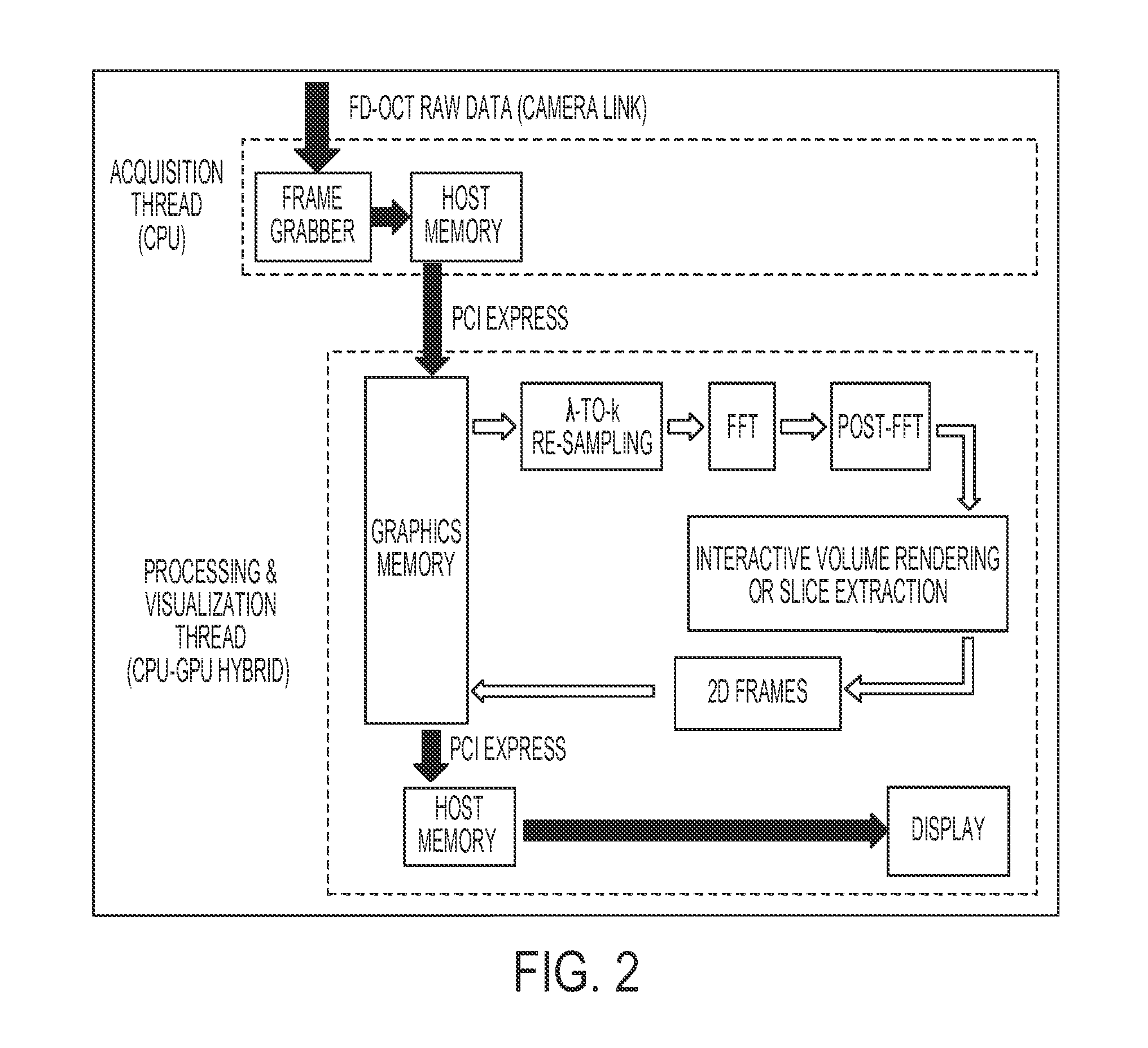Real-time, three-dimensional optical coherence tomograpny system
- Summary
- Abstract
- Description
- Claims
- Application Information
AI Technical Summary
Benefits of technology
Problems solved by technology
Method used
Image
Examples
example 1
System Configuration and CPU-GPU Hybrid Architecture
[0088]FIG. 1 is a schematic illustration of an FD-OCT system used in an example according to an embodiment of the current invention. In this example, a 12-bit CMOS camera (Sprint spL2048-140k, Basler AG, Germany) with 70,000 line / s effective line rate at 2048 pixel mode functions as the detector of the OCT spectrometer. A superluminescence diode (SLED) (λ0=825 nm, Δλ=70 nm, Superlum, Ireland) was used as the light source, which gives an axial resolution of approximately 5.5 μm in air / 4.1 μm in water. The beam scanning was implemented by a pair of high speed galvanometer mirrors driven by a dual channel function generator and synchronized with a high speed frame grabber (PCIe-1429, National Instruments, USA). To simplify alignment issues, the OCT system was configured in a common-path mode, where the reference signal comes from the bottom surface reflection of a glass window placed in between the scanning lens and sample, while the ...
example 2
[0112]As mentioned above, for most conventional FD-OCT systems, the raw data is acquired in real-time and saved for post-processing. For microsurgeries, such imaging protocol provides valuable “pre-operative / post-operative” images, but is incapable of providing real-time, “inter-operative” imaging for surgical guidance and visualization. In addition, standard FD-OCT systems suffer from spatially reversed complex-conjugate ghost images that could severely misguide the users. As a solution, the complex full-range FD-OCT (C-FD-OCT) has been utilized, which removes the complex-conjugate image by applying a phase modulation on interferogram frames. See, for example:[0113]Y. Yasuno, S. Makita, T. Endo, G. Aoki, M. Itoh, and T. Yatagai, “Simultaneous B-M-mode scanning method for real-time full-range Fourier domain optical coherence tomography,” Appl. Opt. 45, 1861-1865 (2006).[0114]B. Baumann, M. Pircher, E. Götzinger and C. K. Hitzenberger, “Full range complex spectral domain optical cohe...
example 3
[0157]High speed Fourier domain OCT (FD-OCT) has been proposed as a new method of microsurgical intervention. However, conventional FD-OCT systems suffer from spatially reversed complex-conjugate ghost images that could severely misguide surgeons. As a solution, complex OCT has been proposed which removes the complex-conjugate image by applying a phase modulation on interferogram frames (Y. Yasuno, S. Makita, T. Endo, G. Aoki, M. Itoh, and T. Yatagai, “Simultaneous B-M-mode scanning method for real-time full-range Fourier domain optical coherence tomography,” Appl. Opt., 45, 1861-1865 (2006)). Due to its complexity, the signal processing of complex OCT takes several times longer than the standard OCT. Thus, complex OCT images are usually “captured and saved” and post-processed, which is not ideal for microsurgical intervention applications. In this example, we implemented an ultra-high-speed, complex OCT system for surgical intervention applications using a graphics processing unit ...
PUM
 Login to View More
Login to View More Abstract
Description
Claims
Application Information
 Login to View More
Login to View More - R&D
- Intellectual Property
- Life Sciences
- Materials
- Tech Scout
- Unparalleled Data Quality
- Higher Quality Content
- 60% Fewer Hallucinations
Browse by: Latest US Patents, China's latest patents, Technical Efficacy Thesaurus, Application Domain, Technology Topic, Popular Technical Reports.
© 2025 PatSnap. All rights reserved.Legal|Privacy policy|Modern Slavery Act Transparency Statement|Sitemap|About US| Contact US: help@patsnap.com



